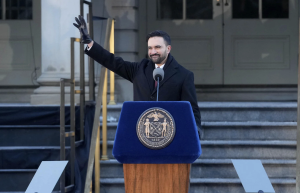Engineers at the Johns Hopkins University Applied Physics Lab (APL) have created a prosthetic unlike any other currently in use: a robotic arm with 26 joints that can curl up to 45 pounds and is controlled with a person's mind just like a regular arm. The new limbs are called Modular Prosthetic Limbs, or MPL.
"It's a relatively new surgical procedure that reassigns nerves that once controlled the arm and the hand," explained Johns Hopkins Trauma Surgeon Dr. Albert Chi, in a December 2014 press release. "By reassigning existing nerves, we can make it possible for people who have had upper-arm amputations to control their prosthetic devices by merely thinking about the action they want to perform."
"We use pattern recognition algorithms to identify individual muscles that are contracting, how well they communicate with each other, and their amplitude and frequency," Chi explained. "We take that information and translate that into actual movements within a prosthetic."
Colorado man Les Baugh lost both arms at the shoulder after an electrical accident 40 years ago. Now 59, Baugh underwent surgery at Johns Hopkins to remap the remaining nerves from his missing arms, allowing brain signals to be sent to the prosthetic.
Then Baugh was fitted for a custom socket for his torso and shoulders that supports the prosthetic limbs and also makes the neurological connections with the reinnervated nerves. Advanced Arm Dynamics designed and fit Baugh's custom prosthetic socket. While the socket got its finishing touches, the team had him work with the limb system through a Virtual Integration Environment (VIE), a virtual-reality version of the MPL.
By the time the socket was finished, Baugh said he was more than ready to get started. When he was fitted with the socket, and the prosthetic limbs were attached, he said, "I just went into a whole different world." He moved several objects, including an empty cup from a counter-shelf height to a higher shelf, a task that required him to coordinate the control of eight separate motions to complete.
"This task simulated activities that may commonly be faced in a day-to-day environment at home," said APL's Courtney Moran, a prosthetist working with Baugh, according to the press release. "This was significant because this is not possible with currently available prostheses. He was able to do this with only 10 days of training, which demonstrates the intuitive nature of the control."
"We expected him to exceed performance compared to what he might achieve with conventional systems, but the speed with which he learned motions and the number of motions he was able to control in such a short period of time was far beyond expectation," Moran said, according to the press release. "What really was amazing, and was another major milestone with MPL control, was his ability to control a combination of motions across both arms at the same time. This was a first for simultaneous bimanual control."
There are still a few hurdles, Mike McLoughlin, the chief engineer of research and exploratory development at the lab recently told The New York Times. First, the limbs have to be approved by the U.S. Food and Drug Administration. Another issue is the cost. There are currently 10 MLSs and they each cost $500,000.
"We've designed a Maserati here, but what most people will want is a good Toyota," McLoughlin said, according to The New York Times. "The M.P.L. was intentionally designed to be as sophisticated as we could make it so that you could really push the state of the art, but ultimately for commercializing it, it needs to be a lower cost design."
Baugh is looking forward to the day when he can just be an average guy doing average things. "Maybe for once I'll be able to put change in the pop machine and get pop out of it," he said, according to the press release. He's looking forward to doing "simple things that most people don't think of. And it's re-available to me."
© 2026 HNGN, All rights reserved. Do not reproduce without permission.








